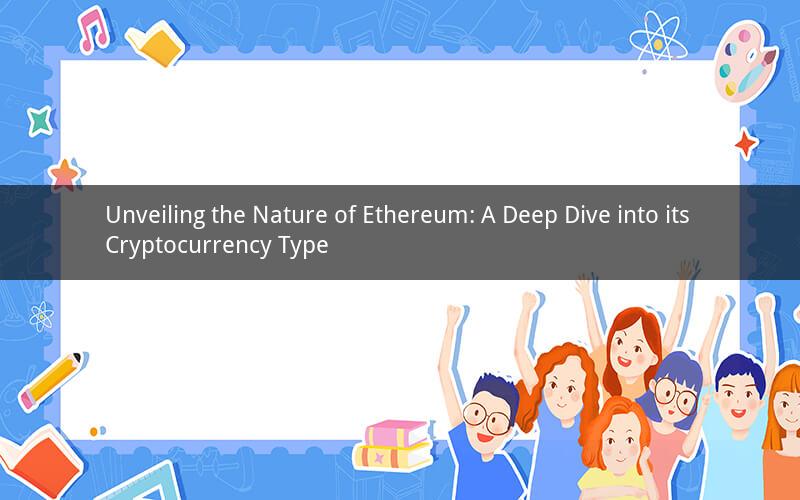
Ethereum, often abbreviated as ETH, has emerged as a pivotal player in the cryptocurrency world. With its unique features and capabilities, it has captured the attention of investors, developers, and enthusiasts alike. In this article, we will explore the type of cryptocurrency that Ethereum represents and delve into its underlying principles, technological advancements, and potential future developments.
I. Understanding Ethereum's Cryptocurrency Type
Ethereum is a decentralized blockchain platform that facilitates the creation and execution of smart contracts and decentralized applications (DApps). It operates as a cryptocurrency, but it is not your typical digital currency like Bitcoin. Ethereum's cryptocurrency type is often referred to as a "platform coin" or "utility token."
1. Platform Coin
Ethereum is a platform coin because it serves as a foundation for building and deploying decentralized applications. Unlike Bitcoin, which primarily focuses on peer-to-peer transactions, Ethereum offers a broader scope of functionalities. By utilizing its native cryptocurrency, Ether (ETH), users can pay for transaction fees, execute smart contracts, and participate in the network's governance.
2. Utility Token
As a utility token, Ether is used within the Ethereum ecosystem to facilitate various activities. It serves as a medium of exchange, a store of value, and a means to incentivize network participants. Users can purchase Ether using fiat currencies or other cryptocurrencies and then use it to pay for transaction fees, participate in governance, or interact with DApps.
II. The Technological Foundation of Ethereum
Ethereum's cryptocurrency type is rooted in its innovative technological foundation. Let's explore some of the key aspects that make Ethereum unique:
1. Blockchain Technology
Ethereum utilizes blockchain technology, a decentralized and distributed ledger system that ensures transparency, security, and immutability. Unlike traditional centralized systems, blockchain allows users to transact directly with each other without the need for intermediaries, reducing costs and increasing efficiency.
2. Smart Contracts
Smart contracts are self-executing contracts with the terms of the agreement directly written into lines of code. They automatically enforce and execute the terms of an agreement when predetermined conditions are met. This feature has revolutionized the way contracts are executed, eliminating the need for intermediaries and reducing time and costs.
3. Gas
Ethereum introduced the concept of "gas" to measure the computational work required to execute smart contracts and perform other operations on the network. Users pay gas fees in Ether to compensate miners for their computational efforts. This mechanism ensures that the network remains efficient and scalable.
III. The Future of Ethereum
Ethereum's cryptocurrency type has paved the way for a wide range of innovative applications. As the platform continues to evolve, several key developments are on the horizon:
1. Ethereum 2.0
Ethereum 2.0 is a major upgrade to the Ethereum network, aiming to enhance scalability, security, and sustainability. It introduces a new consensus mechanism called Proof of Stake (PoS) and a sharded architecture to handle a higher volume of transactions. Ethereum 2.0 is expected to significantly improve the network's performance and reduce its environmental impact.
2. Decentralized Finance (DeFi)
Decentralized Finance is a rapidly growing sector within the Ethereum ecosystem. It enables users to engage in various financial activities, such as lending, borrowing, and trading, without the need for traditional financial intermediaries. As Ethereum continues to evolve, DeFi is expected to become even more prominent, offering innovative financial solutions to users worldwide.
3. NFTs (Non-Fungible Tokens)
Non-Fungible Tokens (NFTs) are unique digital assets that represent ownership or proof of authenticity. Ethereum has become a popular platform for creating and trading NFTs, enabling artists, creators, and collectors to tokenize their work and gain new revenue streams.
IV. Frequently Asked Questions (FAQs)
1. What is the difference between Ethereum and Bitcoin?
Ethereum and Bitcoin are both cryptocurrencies, but they serve different purposes. Bitcoin is primarily a digital currency focused on peer-to-peer transactions, while Ethereum is a decentralized platform that facilitates the creation and execution of smart contracts and DApps.
2. Can I mine Ethereum?
Mining Ethereum is different from mining Bitcoin. Ethereum utilizes a Proof of Stake (PoS) consensus mechanism, which means that mining is no longer required. Instead, users can participate in staking to earn rewards in Ether.
3. How does Ethereum's gas mechanism work?
Ethereum's gas mechanism measures the computational work required to execute smart contracts and perform other operations on the network. Users pay gas fees in Ether to compensate miners for their efforts.
4. What is the role of Ether in the Ethereum ecosystem?
Ether serves as a medium of exchange, a store of value, and a means to incentivize network participants. It is used to pay for transaction fees, execute smart contracts, and participate in the network's governance.
5. How does Ethereum 2.0 aim to improve the network?
Ethereum 2.0 aims to enhance scalability, security, and sustainability by introducing a new Proof of Stake (PoS) consensus mechanism and a sharded architecture. This will allow the network to handle a higher volume of transactions and reduce its environmental impact.
In conclusion, Ethereum's cryptocurrency type, as a platform coin and utility token, has revolutionized the way we perceive and utilize cryptocurrencies. With its innovative technological foundation and potential future developments, Ethereum continues to shape the decentralized ecosystem and offer a wide range of opportunities for users and developers alike.